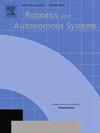新型无人驾驶智能轮足飞行器在非结构化地形上的轨迹优化与稳定性控制
IF 4.3
2区 计算机科学
Q1 AUTOMATION & CONTROL SYSTEMS
引用次数: 0
摘要
目前,智能车辆的发展趋势正在扩大,一种被称为轮腿车辆(WLV)的新型无人驾驶智能车辆正在兴起。WLV 在非结构化地形的运输方面表现出色,它将轮子在平地上的高效性和腿部应对障碍物的多功能性独特地结合在一起。为了提高 WLV 在非结构化地形上的运动性能,本文提出了一个新颖的框架,通过基于非线性编程(NLP)的轨迹优化和稳定性控制来改善 WLV 的运动性能。该框架在结合地形信息的同时优化车辆的车身和车轮定位,并采用线性刚体动态模型进行高效的运动规划。稳定性控制框架结合了使用地面反作用力的前馈控制和通过关节PD控制的反馈控制,并利用模型预测控制(MPC)调整车轮滑移率,以防止在陡坡上打滑。在带有扭矩控制车轮的真实车辆上进行的实验验证表明,该车辆能够以平均 0.7 米/秒和最高 1.03 米/秒的速度驶过 30° 斜坡上 1 米的高度。我们的方法还使 WLV 能够克服斜坡等障碍,同时以动态方式通过这些具有挑战性的地形。本文章由计算机程序翻译,如有差异,请以英文原文为准。
Trajectory optimization and stability control for a novel unmanned intelligent wheel-legged vehicles on unstructured terrains
The trend of intelligent vehicles is currently expanding, and a new class of unmanned intelligent vehicles known as wheel-legged vehicles (WLVs) is emerging. WLVs excel in transportation on unstructured terrain by offering a unique combination of the efficiency of wheels on flat ground and the versatility of legs to tackle obstacles. To enhance the locomotion performance of WLVs on unstructured terrains, this paper presents a novel framework for improving their locomotion through nonlinear programming-based (NLP) trajectory optimization and stability control. The framework optimizes the vehicle’s body and wheel positioning while incorporating terrain information and employs a linear rigid body dynamic model for efficient motion planning. The stability control framework combines feedforward control using ground reaction forces with feedback control through joint PD control and utilizes model predictive control (MPC) to adjust the wheel slip ratio to prevent slip on steep slopes. Experimental validation on the real vehicle with torque-controlled wheels demonstrated the capability of driving over a 1 m height with a 30°slope at an average speed of 0.7 m/s and a maximum speed of 1.03 m/s. Our approach also enables the WLV to overcome obstacles, such as inclines, while dynamically negotiating these challenging terrains.
求助全文
通过发布文献求助,成功后即可免费获取论文全文。
去求助
来源期刊

Robotics and Autonomous Systems
工程技术-机器人学
CiteScore
9.00
自引率
7.00%
发文量
164
审稿时长
4.5 months
期刊介绍:
Robotics and Autonomous Systems will carry articles describing fundamental developments in the field of robotics, with special emphasis on autonomous systems. An important goal of this journal is to extend the state of the art in both symbolic and sensory based robot control and learning in the context of autonomous systems.
Robotics and Autonomous Systems will carry articles on the theoretical, computational and experimental aspects of autonomous systems, or modules of such systems.
 求助内容:
求助内容: 应助结果提醒方式:
应助结果提醒方式:


